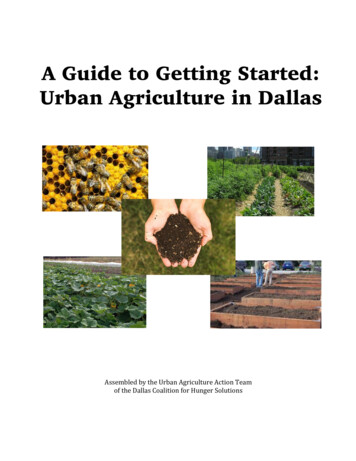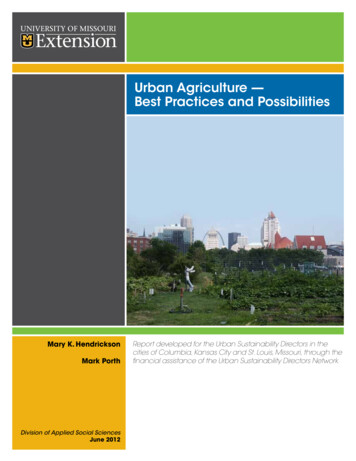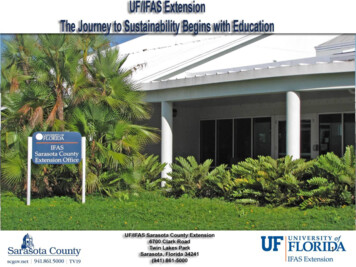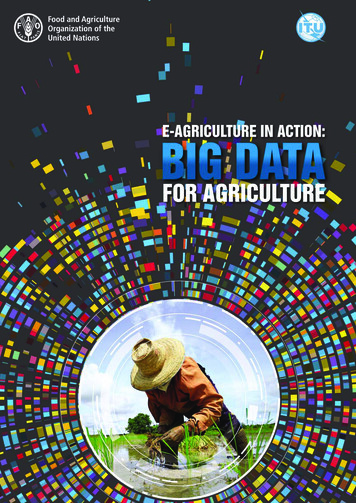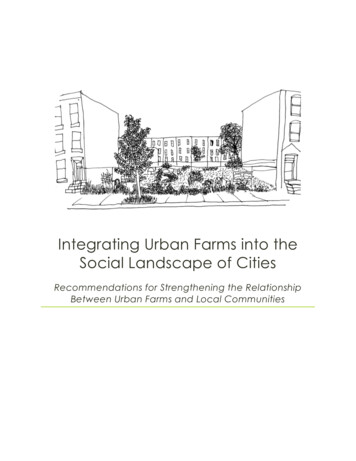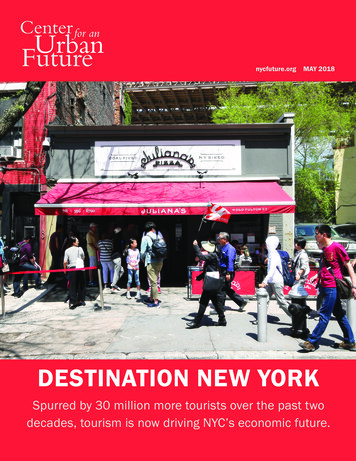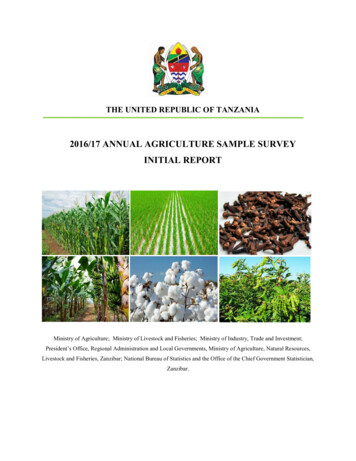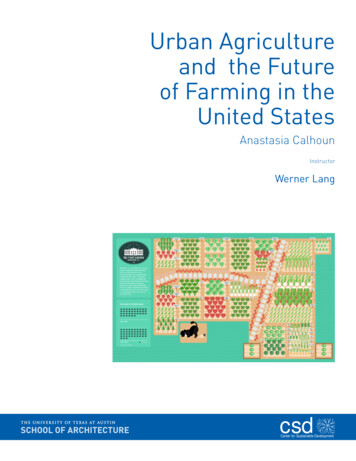
Transcription
Urban Agricultureand the Futureof Farming in theUnited StatesAnastasia CalhounInstructorWerner LangcsdCenter for Sustainable Development
The University of Texas at Austin - School of Architecture - UTSoAUrban Agriculture and theFuture of Farming in the UnitedStatesAnastasia CalhounFig. 01 Diagram of the Obamas’ White House GardenIntroductionThe procurement of food is perhapsthe most basic necessity of life, andyet what we eat and the way we eathas never been so hotly debated.Authors like Michael Pollan andMorgan Spurlock expose realities ofour current system of food productionthat can make readers feel squeamishat best and, more frequently, morally outraged. So these questions begto be asked: How did we get to thispoint and in what direction should wehead? This paper will examine thedevelopment of agriculture and lookat the role urban agriculture can playin creating a new paradigm for foodproduction in the United States.The Origins and Development ofAgricultureFor most of his history, mankind hassupported himself through the huntingof wild animals and foraging for wildplants. Since little food was grown andstored, life was a constant struggleagainst starvation. The escape fromthis existence began 10,000 yearsago with the domestication of plantand animal species. This revolutionspread throughout the world untilall but a handful of hunter-gatherertribes remain today.1The exact origins of agriculture areunknown since the development offarming predated the advent of writing. It is believed that agriculturedeveloped simultaneously in multiplesites throughout the world, includingthe Fertile Crescent of Western Asia,Egypt, India, China, parts of Africa,and several regions in the Americas.There is no consensus amongst researchers as to the exact cause of thisdevelopment. However, either becauseof an increase in population or population density, the carrying capacityof the immediate environment wassurpassed.2 Because planted cropsyield far more tons per acre than wildroots and berries, agriculture wasa far more efficient way to supportlarger populations with more food for
The University of Texas at Austin - School of Architecture - UTSoAUrban Agriculture and the Future of FarmingThe development of agriculturaltechnology that occurred between1943 and the 1970’s became knownas the Green Revolution. Theimplementation of energy-intensivefarming techniques such as the useof pesticides, synthetic nitrogenfertilizer, and hybridized crop varieties resulted in unprecedented cropyields. Worldwide grain productionincreased by 250% between 1950and 1984, while the world population merely doubled. While the useof these techniques has radicallydropped food prices and increasedfood security in western countries,it has done so at a high cost to theenvironment, public health, andeconomic security for agriculturalworkers.6Problems of Industrial AgricultureFig. 02 Illustration demonstrating the increase in wheat production since 1961less work.By 6,000 BC, mid-scale farmingwas firmly established in Egypt, andagriculture had developed in theFar East with the cultivation of riceand highly organized systems of netfishing. These new systems allowedfor a population boom that continuesto this day.3 By 5,000 BC, the Sumerians had developed agriculturaltechniques including large-scaleintensive agriculture, monocropping,and organized irrigation. Agricultural efficiency continued to improvethrough the Middle Ages with thedevelopment of irrigation systemsbased on hydraulic and hydrostaticprinciples, a three-field system ofcrop rotation, and the moldboardplow.4 The rapid rise of mechanization in the 19th and 20th centuriesallowed farming to be performedincreasingly efficiently and at largerscales.5Land degradation is one of the mosttroublesome outcomes of modernfarming techniques. This can present itself in the form of soil erosion,deforestation, acidification, salinization, and nutrient depletion. Secondary effects of these processes canadd to environmental degradation.For example, erosion of nutrient-richtopsoil contributes to the eutrophication process of algae. Under thesecircumstances, the algae populationrapidly explodes, decreasing the water’s oxygen content , resulting in fishkills, loss of bio-diversity, and thecontamination of drinking water. (6)Livestock production in particularis a massive contributor to globalwarming. It uses 30% of the landsurface of the planet and is responsible for 18% of the world’sgreenhouse gas emissions relativeto carbon dioxide emissions. Additionally, it generates 65% of humanrelated nitrous oxide, which has 2962
The University of Texas at Austin - School of Architecture - UTSoAUrban Agriculture and the Future of Farmingneighborhoods, where cheap, fast,nutrient-depleted food abounds. Because it is almost impossible to findfresh produce, these neighborhoodshave to come to be known as “fooddeserts”.10The Green Revolution also made asignificant socioeconomic impacton farmers. Since industrializationrequired higher startup costs thanmore traditional farming techniques,farmers often went into debt, whichin many cases resulted in the loss oftheir farmland. Because wealthierfarmers had better access to creditand land, the Green Revolution increased class disparities. 11Fig. 03 Industrial farmingFig. 04 Allotment garden in Munichtimes the global warming potentialof CO2, and 37% of human-inducedmethane. It also produces 64% ofthe ammonia, which contributes toacidification of ecosystems.7In addition to environmental damage,industrial agriculture is implicatedin multiple public health problemsincluding pesticide and food poisoning, increased cancer risk, obesity,and malnutrition. Food recalls due tocontamination by salmonella and e.coli are becoming increasingly common.8 The World health organizationattributes 220,000 deaths per year topesticide poisoning, and long-termexposure to pesticides has beenlinked with higher cancer rates. 9And the most ironic of health problems, is the simultaneous increaseof obesity and malnutrition. Thereare communities across America,most often low-income, inner-cityOne of the greatest challenges facingindustrial agriculture is its relianceon fossil fuels. Direct consumption on farms includes the use oflubricants and fuels to operate farmvehicles and machinery. Indirectconsumption is mainly due to themanufacturing of fertilizers andpesticides. Finally, since industriallyproduced food travels an averageof 1,500 miles from farm to fork,transportation is a major consumerof fossil fuels in this system. For thisreason alone, it is evident that thiscurrent system of food productioncannot be sustained as oil reservesare depleted. The question is whether we will implement new methodsof food production before the worldwide famines become a reality.Why Urban Agriculture?Urban Agriculture provides a viable alternative to today’s standardmethods of food production. UrbanAgriculture is the growing, processing, and distribution of food throughintensive plant cultivation and animalhusbandry in and around cities.123
The University of Texas at Austin - School of Architecture - UTSoABecause the initial development ofcities 10,000 years ago was a directresult of agriculture, it is only naturalthat agriculture should be intrinsicto towns and cities and contemporary society. Opportunities for urbanagriculture are almost endless asthis type of agriculture can occur onvirtually any scale and in any location, from a window box garden to amulti-acre site. They can be locatedin greenbelts around cities or invacant inner-city lots. They can beprivately owned, commercial enterprises, municipally run, or non-profitendeavors.The benefits to the environment andto society offered by urban agriculture are just as numerous as themany physical forms it can take. Anincrease in green spaces resultsin cleaner air, lower summer temperatures, humidity regulation, andthe reduction of greenhouse gases.It also provides noise filtering andpromotes biodiversity. Urban agriculture can use its own waste and thatof its community to create more foodthrough the composting of organicmatter and processing of grey water.residents would improve with accessto more nutritious food and opportunities for exercise associated withgardening. Gardening 3-4 times perweek has the same health benefitsas moderate walking or moderate bicycling.14 The ability to influence theirimmediate environments creates asense of empowerment in individu-Urban Agriculture and the Future of Farmingals, which can also help to reducestress and anger. Green spacescreate a sense of community throughproviding a place for social gatherings. In general, when the food security of a community increases, crime,health care costs, and requirementsfor city services decrease.15Fig. 05 Urban farming in CubaPurchasing food that is locally growndecreases energy needs and costsassociated with long distance traveland refrigeration. Fruits and vegetables shipped between states canspend 7-14 days in transit. Nearly50% of food is lost before it ever hitsthe shelves.13 Because of this, mostvarieties of produce sold in storesare selected based on their abilityto handle extended travel. Growinglocally would allow for greater varieties of crops that are selected fortheir taste and nutritional qualitiesrather than their shelf-lives.The physical and mental health ofFig. 06 Intercultural garden in Munich4
The University of Texas at Austin - School of Architecture - UTSoAFig. 07 Urban farming in AfricaFig. 08 Urban Farming in TokyoFig. 09 Urban farming in DetroitFig. 10 Vertical farming in El PasoFinally, urban agriculture can providenumerous economic benefits to acommunity. In addition to the obviousreduction in food costs, it can provideopportunities for entrepreneurshipand create local jobs. The full economic potential of urban agriculturebecomes apparent when considering the possibilities for regional foodconnections. Maintaining regionaland local farm to consumer enterprises helps keep the entire industryaccountable for the food system,increasing the likelihood that foodis produced and consumed in sustainable ways and helps support thelocal economy.Urban Agriculture and the Future of FarmingUrban Agriculture in MunichMunich provides examples formultiple types of urban agriculturewhich can serve as useful examplesof systems that could be implemented in the United States. TheCity of Munich owns approximately5,000 acres of farmland and 12,0005
The University of Texas at Austin - School of Architecture - UTSoAUrban Agriculture and the Future of FarmingThe farms currently feed about10,000 Munich residents using asystem similar to the CommunitySupported Agriculture farms in theUnited States. Fresh local fruits,vegetables, and dairy products aredelivered to subscribers’ doors on aweekly or bi-weekly basis. Residentscan also obtain these goods threedays per week from the retail shoplocated on the farm. The farms alsosupply food to the cafeterias at localkindergartens.Allotment gardens are a collectionof parcels of land that are rentedby individuals or families and arethe most widely-used communityagriculture typology in Munich. Thereare approximately 100 different allotment gardens in Munich with 35,000users.16 These plots are cultivatedindividually rather than collectivelytended, as in other types of community gardens. They range in size from500 to 4,000 square feet and oftencontain a small shed for tool storage and shelter. The gardeners areorganized in an allotment associationwhich leases the land from owner,who may be a public, private, orecclesiastical entity. The gardenershave to pay a small membership feeand must abide by the organization’sby-laws.Fig. 11 Victory garden campaign poster circa WWIIacres of forest. In addition to thesemunicipal farms, there are over 800participatory gardens in Munichwhere approximately 50,000 peoplework collaboratively. Munich is one ofthe few remaining German cities toown its own farmland. The StadgüterMünchen is a collection of urbanfarms owned and operated by the cityof Munich, half of which are ecologically certified. The land consists of agreenbelt surrounding the city andtwelve other farms in the area. Munichbegan acquiring land about 100 yearsago to allow for urban growth and isone of the few remaining German cities to own public farmland. The landserves multiple functions includingfood production, research of soil andwater quality, education, rehabilitation of native habitats, and as an areafor leisure. Additionally, lands thatare unsuitable for food productiondue to environmental contaminationare used for biogas production.Originally called “gardens of thepoor”, gardens of this type originatedin Germany in the 19th century andwere developed in poor, immigrantneighborhoods as a means to provide food security for neighborhoodresidents. This concept was furtherdeveloped during the First and Second World Wars when food securitywas a problem facing the country asa whole. While food production is stilla considerable benefit of this type ofgarden, they are now used primarily6
The University of Texas at Austin - School of Architecture - UTSoAUrban Agriculture and the Future of Farmingas a place for community interactionand recreation.17Krautgartens came from Vienna toMunich in 2004 as a response to thehigh-demand and limited availability of allotment gardens. The herbgarden parcels are smaller than thosetypically found in an allotment gardenand appeal to a new demographic ofpeople. The land is rented from Mayto November and then returned tothe farmer at the end of the growingseason. There are currently twelvekrautgartens with about 2,000 users inMunich.18The first intercultural gardens wereestablished in Germany in 1996 asa means to promote relationshipsbetween refugees, immigrants, andnative-born residents. The gardensprovide an avenue for communityparticipation and are seen as an idealopportunity since many immigrantsand refugees come from small farming communities and can apply theirfarming knowledge in Germany. Likethe other types of garden alreadymentioned, the land is divided intoparcels for growing vegetables andherbs, including varieties from immigrants’ countries of origin. Thesespaces are also used as a recreationalarea for children and a place to holdcommunity events and meetings.19Munich also has about 300 educational gardens located at more than40% of its schools, 3 therapeuticgardens found at nursing homes, andanother 5,000 gardeners in privateresidences.20 In addition to these moreconventional types of community garden groups, Munich has two groups ofGuerilla Gardeners consisting of about40 participants. Guerilla gardenerscan now be found worldwide and are agroup of rogue gardeners that inde-Fig. 12 Urban garden created in a bomb crater in London circa WWIIFig. 13 Victory farmers7
The University of Texas at Austin - School of Architecture - UTSoApendently green public spaces withoutapproval and at their own expense.They typically focus on greeningneglected and impoverished urbanspaces. They establish relationshipswith local residents and businessesand encourage their participation inthe project through the maintenanceof the space.21Potential Criticisms of Urban Agriculturethat will loan or rent tools at a reasonable price.Marketing of locally-grown foodscan be challenging when in competition with wholesale distributors.Solution: Food buying groups and cooperatives are popular ways for consum-Urban Agriculture and the Future of Farmingers to pool their orders. “Buy Local” and “Slow Food” campaigns are increasing the demand forlocally produced foods. School boards and health agenciescan work with farms to bring localfood into institutions.New urban farmers may lack theknowledge and skills required toWhile not intended to be a comprehensive list, the following are someobstacles and potential criticisms thatcould be encountered regarding urbanagriculture:Many involved in urban agriculturedo not own the land they use to growfood. Without title or long-termleases, they run the risk of losingtheir investments.Solution: Some sites are operated underusufruct agreements, meaning thatas long as the property is well maintained, the growers maintain the legalright to use the property.22 Areas such as rooftops, roadsides,and institutional property rarely haveother uses. Many types of urban agriculture canbe mobile or require little investment.These types are well-suited for shorter-term or more uncertain leases.Start-up costs can be prohibitive forpeople on limited incomes. Oftenthese are the same people at whichcommunity gardens are directed.Solution: Financial support can be foundthrough grants, microcredit loans,community donations, etc. Many communities have tool banksFig. 14 Rooftop garden in Brooklyn8
The University of Texas at Austin - School of Architecture - UTSoAUrban Agriculture and the Future of Farmingcan teach canning techniques, oftenemploying the knowledge of elderlymembers of the community.Many areas of city land can be contaminated.Solution: Raised beds can be used so thatgrowing soil is separate from contaminated ground soil. Low-cost soil testing is availableto determine whether or not a site iscontaminated.23 Sheltered production methods canbe used such as greenhouses, indoorproduction, hydroponic growing mediums, etc.Gardens could be subject to vandalism and crime.Solution: Incorporate youth programs toprovide constructive activities andleadership opportunities. Community gardens help cultivategood relationships with neighborsand law enforcement, creating a “human fence”. Higher foot traffic from communitygardens can increase the safety ofsparsely populated areas by keeping“eyes on the street”.The only way to grow enough foodto feed the world’s population isthrough industrial agriculture.Fig. 15 Urban goat living in Oaklandproduce successful crop yields.Solution: Nonprofit organizations are available to train groups in urban agriculture techniques. Many successful gardening programs in schools educate youth onproper gardening techniques.In many climates, food productionis not always viable as a year-roundsource of food security.Solution: The use of green houses, wasteheat, etc., can extend the growingseason considerably. Urban agriculture educatorsSolution: Small farms can be 4-100 timesmore productive in total output peracre than industrial farms.24Small-scale and sustainable farming techniques are too expensive.Solution: Growing your own food organicallyis less expensive than buying indus-9
The University of Texas at Austin - School of Architecture - UTSoAtrially produced foods at retail prices. The price tag on industrially produced foods does not reflect the addedcosts of environmental clean-up andhealthcare. Growing food in a sustainable way will decrease the overall costof living.Is an agricultural revolution possible?According to John Jeavons and Ecology Action, a human being can feedhimself on as little as 700 sq. ft. ofgarden space.25 Granted, most peoplewould prefer a diet with more varietythan this size of space allows, but acomfortable existence would be possible. If one adds the space availablein residential yards, public parks,commercial green spaces, etc., thereare 7,000,000 acres of existing greenspace in cities.26 If all of these spaceswere used for food production, wecould feed 434,000,000 people - about40% more people than currently live inthe United States today. Millions morecould be fed if land area occupied byrooftops, about 30% of the averagecity’s total land area, were turned intoareas for food production. The amouont of land area available for farmingconsinues to climb when considering the 130,00 to 425,000 brownfieldsidentified by the U.S. General Accounting Office as areas that could be safelyconverted to agricultural purposeswhen properly redeveloped.27The reality is that in the not-so-distantpast the United States has shown itsability to truly effect a radical changein food production. At the beginning ofWorld War II, victory gardens emergedas a way to produce food and reducedemand on materials used in foodprocessing and canning. The USDAestimated that in the final three yearsof the war over 20 million garden plotsUrban Agriculture and the Future of Farmingwere planted producing 9-10 millionpounds of fruits and vegetables peryear, which is about 44% of the totalamount of fresh produce in the UnitedStates.10 Examples like this and thosefound in Munich demonstrate thatmassive, large-scale change is possible and that urban agriculture is aviable alternative to current methodsof food production.PrimerCFSCUAC.pdfNotes17. Landesverband Bayerischer Kleingärtnere.V., Geschichte, http://www.l-b-k.de/1. Jared Diamond, “The Worst Mistake in HumanHistory”, Minnesotans for Sustainability, http://www.mnforsustain.org/food ag worst mistake diamond j.htm. (accessed June 27, 2010)2. History of Food and Agriculture, Pre-agricultural times, /fresque/la fresque.htm(accessed June 27, 2010)3. Wikipedia, http://en.wikipedia.org/wiki/Agriculture (accessed June 27, 2010)4. ibid.13. ibid.14. ibid.15. ibid.16. Ella von der Haide, “Urbane partizipativeGartenaktivitäten in München 2009 Neue Räumeder Begegnung und Subsistenz, der Partizipation und des Naturerlebens für alle”, tes/default/download/studie urb lw.pdf18. tes/default/download/studie urblw.pdf19. Stiftung Interkultur, Home Page, http://www.stiftung-interkultur.de/home20. tes/default/download/studie urblw.pdf21. Guerilla Gardening Munich, Über Uns, http://guerillagardeningmunich.weebly.com/5. ibid.22. http://www.foodsecurity.org/PrimerCFSCUAC.pdf6. Wikipedia, http://en.wikipedia.org/wiki/Green Revolution23. ibid.7. ibid.8. Bryan Walsh, “Getting Real About theHigh Price of Cheap Food”, Time magazine, 7458,00.html (accessed July 5,2010)9. Wikipedia, http://en.wikipedia.org/wiki/Green Revolution10. The New York Times Editorial, “FreshFood for Urban Deserts”, tml11. Wikipedia, http://en.wikipedia.org/wiki/Green Revolution12. Community Food Security Coalition’s NorthAmerican Agriculture Committee, “UrbanAgriculture and Community Food Security in theUnited States: Farming from the City Center tothe Urban Fringe”, http://www.foodsecurity.org/24. Sharon Astyk, A Nation of Farmers: Defeatingthe Food Crisis on American Soil (New York: NewSociety publishers, 2009), http://reader.eblib.com.ezproxy.lib.utexas.edu/ (accessed July 5,2010)25. ibid.26. ibid.27. http://www.foodsecurity.org/PrimerCFSCUAC.pdf28. Sprouts in the Sidewalk, “World War II: Victory Gardens the Second Time Around”, FiguresFigure 01: Good, Inc., Obama’s Presidential Garden, JPG, g/trans0609thefirstgarden.jpg10
The University of Texas at Austin - School of Architecture - UTSoAFigure 02: Bill and Melinda Gates Foundation,Chart 4: Africa Missed Out on the Green Revolution, GIF, re 03: Social Entrepreneurs, Cornfield, .com/wp-content/uploads/2009/04/cornfield istock.jpgFigure 04: City Farmer, Urban AgricultureNotes, German Allotment Garden, JPG, http://www.cityfarmer.org/germanAllot.htmlFigure 05: China Daily, Urban Farming in Cuba,JPG, /jpg/site1/20090812/0013729e41140bec98f45b.jpg cubaFigure 06: Stiftung Interkultur, JPG, http://www.stiftung-interkultur.de/Figure 07: Le Centre de recherchés pour ledevelopment international, Urban Farming inAfrica, BMP, http://www.crdi.ca/uploads/userS/1150816664306 urban farming in africa.bmpFigure 08: Metro Tokyo, Urban Farming in Tokyo,JPG, 81104.jpg tokyoFigure 09: Flickr, Urban Farm in Detroit, d8bb079b37.jpgFigure 10: Valcent Blog, Vertical gardenin El Paso, JPG, /veggiegrowoct 10 2007 005.jpgFigure 11: Clemson Cooperative Extension, Victory Gardens making a Comeback, JPG, /veggiegrow oct 10 2007 005.jpgFigure 12: Sprouts in the Sidewalk, Garden Builtout of a London Bomb Crater, JPG, Figure 13: Sprouts in the Sidewalk, Victory Gardeners, JPG, Figure 14: Urban Garden Casual, Rooftop Farmsin Brooklyn, JPG, rms-in-brooklynnew-york/Figure 15: Front Yard Farmer, Dwarf NigerianGoat, JPG, t-on-stairs.jpgReferences1. Astyk, Sharon A Nation of Farmers: Defeatingthe Food Crisis on American Soil (New York: NewSociety publishers, 2009). http://reader.eblib.com.ezproxy.lib.utexas.edu/ (accessed June 27,2010)Urban Agriculture and the Future of Farmingzine, 7458,00.html (accessed July 5,2010)12. Wikipedia, http://en.wikipedia.org/wiki/Agriculture (accessed June 27, 2010)13. Wikipedia, http://en.wikipedia.org/wiki/Green Revolution (accessed July 5, 2010)2. Community Food Security Coalition’s NorthAmerican Agriculture Committee, “UrbanAgriculture and Community Food Security in theUnited States: Farming from the City Center tothe Urban Fringe”, http://www.foodsecurity.org/PrimerCFSCUAC.pdf (accessed July 5, 2010)3. Diamond, Jared, “The Worst Mistake in Human History”, Minnesotans for Sustainability,http://www.mnforsustain.org/food ag worstmistake diamond j.htm. (accessed June 27,2010)4. Guerilla Gardening Munich, Über Uns, http://guerillagardeningmunich.weebly.com/ (accessed July 7, 2010)5. History of Food and Agriculture, Pre-agricultural times, /fresque/la fresque.htm(accessed June 27, 2010)6. Landesverband Bayerischer Kleingärtner e.V.,Geschichte, http://www.l-b-k.de/ 9accessed July7, 2010)7. The New York Times Editorial, “Fresh Foodfor Urban Deserts”, tml (accessedJuly 6, 2010)8. Sprouts in the Sidewalk, “World War II: Victory Gardens the Second Time Around”, (accessed July 7, 2010)9. Stiftung Interkultur, Home Page, http://www.stiftung-interkultur.de/home (accessed July 7,2010)10. Von der Haide, Ella, “Urbane partizipativeGartenaktivitäten in München 2009 Neue Räumeder Begegnung und Subsistenz, der Partizipation und des Naturerlebens für alle”, tes/default/download/studie urb lw.pdf (accessed June 27, 2010)11. Walsh, Bryan, “Getting Real About theHigh Price of Cheap Food”, Time maga-11
Urban Agriculture in Munich Munich provides examples for multiple types of urban agriculture which can serve as useful examples of systems that could be imple-mented in the United States. The City of Munich owns approximately 5,000 acres of farmland and 12,000 Fig.
